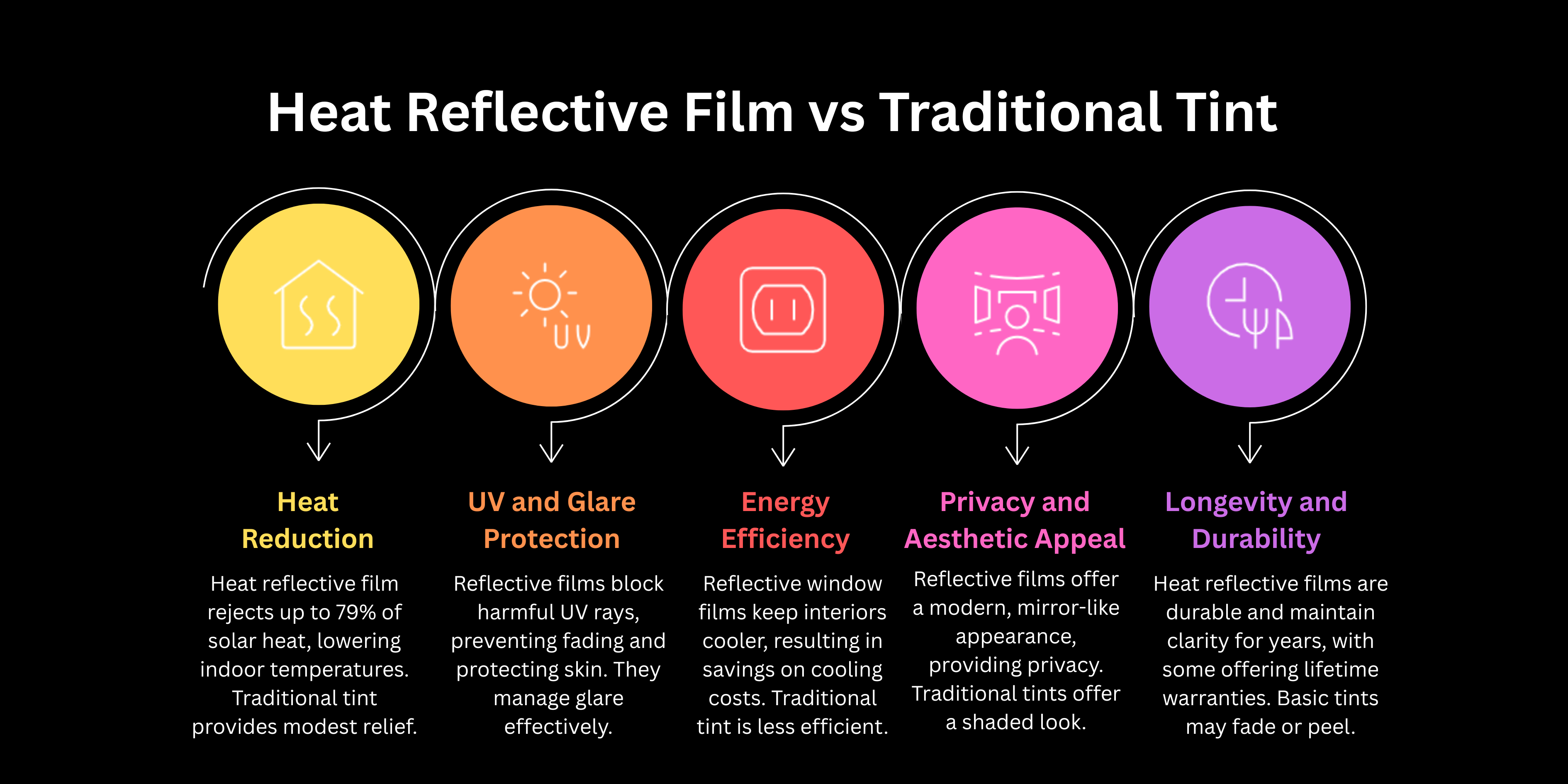Windows do more than let the sunlight in; they shape the atmosphere of your home or office. But with the Florida sun shining bright almost year-round, glass can also bring in unwanted heat, harsh glare, and damaging UV rays. That’s where window films come in.
Many property owners find themselves comparing two popular options: traditional window tint and Heat Reflective Window Film. While both serve important purposes, they differ in performance, benefits, and long-term value. Let’s take a closer look at how they stack up against each other.
What is Traditional Window Tint?
Traditional window tint is a basic film that darkens the glass to give it a shaded look. It’s often used to cut down on glare and add some level of privacy. While it is an affordable option, its ability to block heat is quite limited. In many cases, it also makes rooms feel darker, which may not suit every space.
What is Heat Reflective Window Film?
Heat reflective window film is a more advanced option. It uses special coatings, such as metallic or ceramic layers, to reflect solar energy before it enters through the glass. This type of film is designed to keep rooms cooler, block up to 99% of UV rays, and reduce glare without making the space feel dark. For hot climates like Jacksonville, it’s especially effective in lowering cooling costs and protecting interiors from sun damage.
Key Differences Between Heat Reflective Window Film and Traditional Tint

1. Heat Reduction
Traditional tint provides modest relief by darkening the glass, but heat can still seep through. Heat reflective film for windows, however, is engineered to reject up to 79% of solar heat, dramatically lowering indoor temperatures and cutting down the strain on air conditioning systems.
2. UV and Glare Protection
Both films offer UV protection, but reflective films deliver near-complete blocking of harmful rays. This helps prevent fading of furniture, carpets, and artwork while also protecting skin. Reflective films also manage glare more effectively without making the space overly dim, unlike darker traditional tints.
3. Energy Efficiency
Because reflective window films keep interiors cooler, they directly impact energy bills. Homes and offices see noticeable savings on cooling costs throughout the year. Traditional tint may slightly reduce energy consumption but cannot compete with the efficiency gains of heat reflective solutions.
4. Privacy and Aesthetic Appeal
Traditional tints give windows a shaded look, which works well for those seeking darker glass for privacy. Heat reflective films, however, create a sleek, modern appearance with a mirror-like finish during the day, offering privacy without sacrificing brightness indoors.
5. Longevity and Durability
Basic dyed tints may fade, peel, or bubble over time, especially in strong sunlight. Heat reflective window films are designed with durable layers that maintain clarity and performance for years. Many premium films, such as those offered by All Spec Sun Control, also come with lifetime warranties, ensuring peace of mind.
Cost vs. Value
At first glance, traditional tint seems more affordable. It has a lower upfront cost, making it attractive for budget-conscious projects. However, the real question is value. Reflective films may cost more initially, but they deliver:
- Significant energy savings over time.
- Long-term protection for interiors.
- Greater durability and fewer replacement needs.
When you add up the benefits, heat reflective mirrored window film often proves to be the smarter investment, especially in climates with intense sunlight.
Which Option is Right for You?
Choosing between the two depends on your goals. If you only need mild glare reduction at a lower cost, traditional tint might serve you well. But if you want a comprehensive solution, lower cooling bills, improve d comfort, UV protection, and a modern look, heat reflective UV window film is the clear winner.
For Jacksonville homeowners and businesses, reflective films are particularly effective because they directly address the region’s hot climate and strong sun exposure. With expert installation, you’ll enjoy a space that feels cooler, looks better, and costs less to maintain.
Final Thoughts
Windows shouldn’t be a source of discomfort or high energy costs. Both traditional tint and heat reflective window film offer solutions, but their benefits differ greatly. Traditional tint may give you shade and privacy, but heat reflective film provides a full spectrum of advantages, from energy efficiency to long-lasting durability.
If you’re ready to enhance your home or office, the team at All Spec Sun Control brings over 30 years of expertise in delivering customized window film solutions. Whether it’s managing glare by day or the subtle effects of film in the night, their premium materials and skilled installation ensure your investment pays off for years to come.
Schedule a consultation today!
FAQs
1. Does heat reflective window film UV make my windows too dark?
No. Unlike traditional tint, reflective films are designed to reduce heat and glare while still allowing natural light to brighten your space.
2. How long does heat reflective window film last?
High-quality films, especially when installed by professionals, can last decades. Many come with lifetime warranties to guarantee durability.
3. Will reflective window film help lower my energy bills?
Yes. By blocking a large portion of solar heat, reflective films reduce the need for air conditioning, which leads to noticeable energy savings over time.
4. Can I install heat reflective film on both residential and commercial properties?
Absolutely. These films are versatile and effective for homes, offices, and even retail spaces, providing comfort and protection across all types of buildings.

